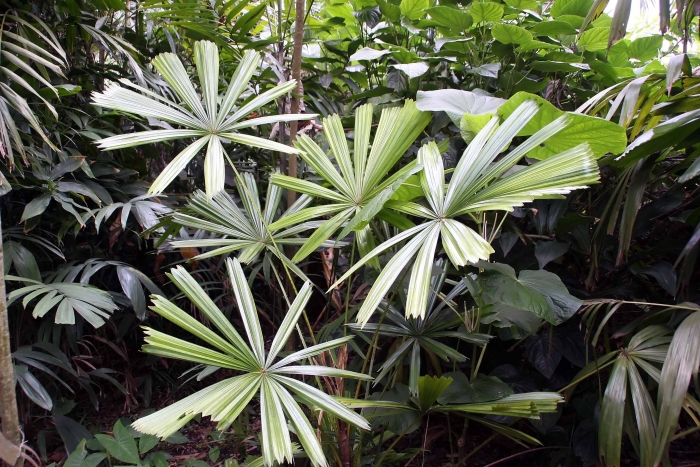Mangrove Fan Palm
(Licuala spinosa)
Mangrove Fan Palm (Licuala spinosa)
/
/

Photo by David J. Stang
CC BY-SA 4.0
Image By:
Photo by David J. Stang
Recorded By:
Copyright:
CC BY-SA 4.0
Copyright Notice:
Photo by: Photo by David J. Stang | License Type: CC BY-SA 4.0 | License URL: https://creativecommons.org/licenses/by-sa/4.0 | Uploader: David Stang | Publisher: Wikimedia Commons | Title: Licuala_spinosa_1zz.jpg | Notes: Photo of ''[[Lilium candidum]]'' Botanical Garden]], taken July 2005 by [[User:Stan Shebs]] {{GFDL-self}} |

















Estimated Native Range
Summary
Licuala spinosa, commonly known as Mangrove Fan Palm, is a clumping palm species native to coastal swamps, mangrove forests, and riverbanks in Southeast Asia and the Western Pacific. It is a slow-growing palm that can reach heights of 2 to 7 meters (6.6 to 23.0 ft) with slender trunks measuring 4-7 cm in diameter. The leaves are large, fan-shaped, and segmented, giving it a distinctive appearance. Mangrove Fan Palm produces small, white flowers during the summer, which are followed by round, red fruit that are attractive to wildlife. The heart and terminal bud are edible and considered a delicacy in Cambodian cuisine.
This palm is valued for its tropical aesthetic and is often used in ornamental plantings in warm climates. It is relatively easy to maintain, requiring full sun to part shade and consistent moisture, making it suitable for planting near water features or in areas with high humidity. It is more cold hardy than most Licuala species, but still requires protection from frost. In cultivation, it is important to provide soil with medium drainage to prevent root rot. While generally disease-resistant, it can be susceptible to pests such as spider mites and scale insects.CC BY-SA 4.0
This palm is valued for its tropical aesthetic and is often used in ornamental plantings in warm climates. It is relatively easy to maintain, requiring full sun to part shade and consistent moisture, making it suitable for planting near water features or in areas with high humidity. It is more cold hardy than most Licuala species, but still requires protection from frost. In cultivation, it is important to provide soil with medium drainage to prevent root rot. While generally disease-resistant, it can be susceptible to pests such as spider mites and scale insects.CC BY-SA 4.0
Plant Description
- Plant Type: Tree
- Height: 7-23 feet
- Width: 6-15 feet
- Growth Rate: Slow
- Flower Color: White
- Flowering Season: Summer
- Leaf Retention: Evergreen
Growth Requirements
- Sun: Full Sun, Part Shade
- Water: High
- Drainage: Medium
Common Uses
Low Maintenance, Potted Plant
Natural Habitat
Native to coastal swamps, mangrove forests, and riverbanks in Southeast Asia and the Western Pacific
Other Names
Common Names: Palas
Scientific Names: , Licuala spinosa, Licuala pilearia, Licuala horrida, Corypha pilearia, Licuala acutifida subsp. peninsularis, Licuala acutifida var. peninsularis, Licuala ramosa, Licuala spinosa subsp. cochinchinensis, Licuala spinosa subsp. eriantha
GBIF Accepted Name: Licuala spinosa Wurmb